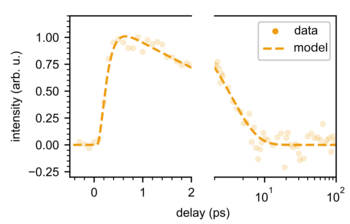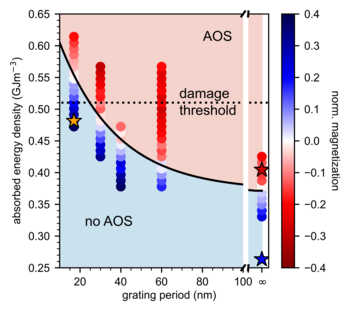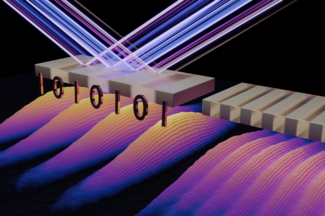Modern magnetic hard drives can store more than one terabit of data per square inch, which means that the smallest unit of information can be encoded on an area smaller than 25 nanometers x 25 nanometers. Therefore, to realize the full potential of laser-based, all-optical switching (AOS), particularly in terms of faster write/erase cycles and improved power efficiency, we need to understand whether a nanoscale magnetic bit can still be all-optically reversed.
For AOS to take place, the magnetic material has to be heated up to very high temperatures in order for its magnetization to be reduced close to zero. Only then, its magnetization can reverse. The twist in AOS is that it is sufficient to heat the electrons of the material while leaving the lattice of atoms cold. This is exactly what an optical laser pulse does; it interacts only with the electrons, allowing to reach much higher (electron) temperatures with very low power levels. However, since hot electrons cool very rapidly by scattering with the cold atoms, the magnetization must be reduced within this characteristic time scale, i.e. AOS relies on a careful balance between the evolution of the (electron) temperature and the loss of magnetization. It is easy to see that this balance is changed when the excitation is confined to the nanoscale: now electrons can not only lose energy to atoms but also by diffusing out of the nanometer-small hot regions. On the nanoscale all these processes happen on comparable ultrafast time scales, such that the electrons may cool too quickly, the magnetization is not sufficiently decreased, and AOS breaks down.
An international team of researchers has for the first time successfully addressed the question of “how small does AOS work” by combining soft X-ray transient grating spectroscopy with atomistic spin dynamics calculations. They produced an extremely short-lived pattern of dark and bright stripes of laser light by interference at the sample surface of the prototypical magnetic material GdFe. The novelty of the experiment is based on the use of laser light in the soft X-ray spectral range, so that the distance between dark and bright areas could be reduced to just 8.7 nanometers. This leads to a lateral modulation the (electron) temperatures and to a corresponding localized loss of magnetization. Subsequently, the ultrafast spatial evolution of the magnetization grating was probed by diffracting a third soft X-ray pulse with a wavelength of 8.3 nm. At this particular wavelength, an electronic resonance at the gadolinium atoms allows the soft X-ray pulse to “feel” the presence of magnetization and thus the change of the magnetization can be detected with femtosecond temporal and sub-nanometer spatial resolution. Combining the experimental results with state-of-the-art simulations, the researchers could determine the nanoscale and ultrafast energy transport. It turns out that the minimum size for AOS in GdFe alloys, induced by a nanoscale periodic excitation, is around 25 nm. This limit is due to ultrafast lateral electron diffusion, which rapidly cools the illuminated regions on these tiny length scales and ultimately prevents AOS. The faster cooling due to electron diffusion can be compensated to some extent by increasing the excitation power, but this approach is ultimately limited by the structural damage caused by the intense laser beam. The researchers expect that the 25 nm boundary is rather universal for all metallic magnetic materials.


